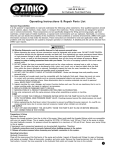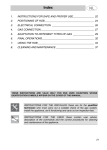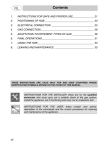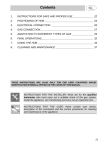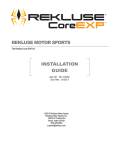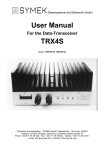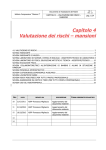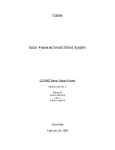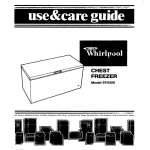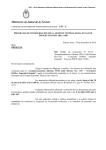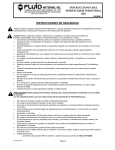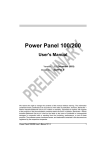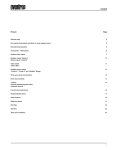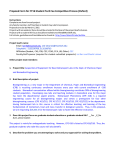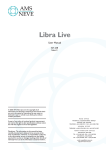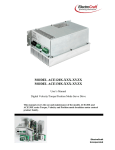Download Automated Beverage Dispenser - School of Electrical and Computer
Transcript
Proposal Automated Beverage Dispenser ECE 4007 Senior Design Project Section L04, Keezer Mike Fojas Katrina Kumm Nick Migliaccio Mark Peterson Nick White Submitted February 4, 2009 TABLE OF CONTENTS Executive Summary.................................................................................................................iii 1. Introduction......................................................................................................................... 1 1.1 Objective......................................................................................................................... 1 1.2 Motivation....................................................................................................................... 1 1.3 Background..................................................................................................................... 2 2. Project Description and Goals ............................................................................................ 3 3. Technical Specifications...................................................................................................... 5 3.1 Software.......................................................................................................................... 5 3.2 Hardware......................................................................................................................... 6 4. Design Approach and Details ............................................................................................. 7 4.1 4.2 Design Approach............................................................................................................ 7 Codes and Standards .................................................................................................... 10 5. Schedule, Tasks, and Milestones....................................................................................... 10 6. Project Demonstration ...................................................................................................... 12 7. Marketing and Cost Analysis ........................................................................................... 12 7.1 7.2 Marketing Analysis ...................................................................................................... 12 Cost Analysis ............................................................................................................... 12 8. Summary ........................................................................................................................... 14 9. References.......................................................................................................................... 15 Appendix A ............................................................................................................................. 16 Appendix B.............................................................................................................................. 17 Appendix C ............................................................................................................................. 19 Automated Beverage Dispenser (ECE4007L04) ii EXECUTIVE SUMMARY The Automated Beverage Dispenser (ABD) is a self contained unit that allows restaurants and bars to cost-effectively and efficiently dispense mixed drinks for their customers without additional personnel. A touch screen computer allows the user, a waiter or bartender, to input the desired drink and the ABD will dispense the specified amounts of liquid that make up the drink recipe. The touch screen computer also allows for the adjustment, addition, and subtraction of recipes and available liquids in the database. Within the computer’s menu, there are also maintenance and help screens to walk the user through processes needed to maintain the unit or the database. Using the device will allow the waiters or bartenders to remotely places and fill orders without directly measuring and pouring the liquids. The machine helps with liquid and cost control by dispensing precise amounts of the liquids. Also, the ABD controls employee cost by allowing current staff to place orders without additional bartenders working. The unit will cost approximately $3,000 base price, however, it has the ability to be expandable to support more than five different liquids. The expandable units would cost approximately $750 for the hardware of additional pumps, hoses and wiring to the existing control unit. The device will be built in compliance with all food and beverage industry codes and standards. The target market for this device is a chain restaurant with bars and bars themselves that need to increase their efficiency and cost-effectiveness when dispensing mixed drinks. The outcome at the end of the specified design period is to be only a prototype. Additional features will not be designed due to time constraints. However, these additional features will be kept in mind during the design period for ease of incorporation. Automated Beverage Dispenser (ECE4007L04) iii AUTOMATED BEVERAGE DISPENSER 1. INTRODUCTION Restaurant and bar businesses are always looking for ways to reduce cost and increase efficiency. One way to achieve both is to reduce human error and human cost. The ABD is a product that can assist chain restaurants and bars achieve both efficiency and cost effectiveness when dispensing drinks. The ABD design group will provide restaurants and bars with a machine that will precisely dispense mixed drinks also while reducing the required human labor to perform it. 1.1 Objective The purpose of the ABD is to expedite the mixing and serving of drinks at restaurants and bars. The system is expandable from the base design, allowing for the addition of different liquids available for dispensing and an extensive database of recipes ready to be made. The system can also be integrated with the current computerized register used by the client allowing for easy pricing and ticketing. Finally, the system is self-contained to allow for simple and space efficient installation. 1.2 Motivation Today in most restaurants that contain bars, the bartenders are responsible for filling the orders for bar and the rest of the restaurant. On nights that the restaurant is very busy, the only current solution is to hire more staff to assist the bartender in making drinks. No commercially available product exists to automatically mix, dispense and serve drinks. The ABD would allow the waiters or bartender to input the ordered drink and serve it without having to mix and pour the required liquids. Also, the ABD assists in liquid control by dispensing the precise amounts and portions of the liquids. By controlling the liquid dispensing, product costs are reduced, Automated Beverage Dispenser (ECE4007L04) 1 allowing the restaurant to increase cost to profit ratios on each drink sold. Also, labor costs are reduced because the extra employees are not required. 1.3 Background Touch Screen Programmable Logic Computer Using a touch screen computer to control the ABD allows easy access and saves on space by not having a keyboard. A programmable logic computer provides a user interface to control equipment with minimal human interaction. A touch screen PLC is the most efficient way for the user to automatically control the equipment of the ABD. A company called B&R Industrial Automations is supplying the touch screen programmable logic computer that will be used. The computer can be easily interfaced with the Input/Output controller also supplied by B&R Industrial Automations. Input/Output Modules An input/output module is used in conjunction with the touch screen PLC to use the user’s input to control the ABD output. Also, the I/O module can be used to gather information about the ABD by reading the outputs of sensors, such as temperature sensors and level sensors. B&R Industrial Automations will also supply the I/O module that will communicate with the PLC, liquid pump system and output sensors. Finally, an Ethernet Powerlink platform will be used in conjunction with the I/O module to make it remote. The Ethernet Powerlink allows the I/O module to be remotely controlled by the PLC. Designing the I/O controller to be remote will allow the ABD to be installed in or near the bar while the PLC can be placed anywhere in the restaurant [1]. Also, the modules can operate ten times the speed of current Fast Ethernet protocols [2]. Automated Beverage Dispenser (ECE4007L04) 2 Database – Data Mining A main component of the ABD is the database of recipes and liquids available for dispensing. An efficient database system will be required to maintain the database. Data mining software is an efficient way to maintain data and report the relationship of said data in meaningful ways. If proper software is not used, the data has no real interest because there is no understanding of the data’s relationships. Liquid Pump System A precise way to dispense and deliver the desired amount of liquids is essential to the success of the ABD. Low maintenance and ease of installation are also important features required for this design. A valve-less stepper motor is a simple and accurate way to dispense the liquids [3]. A valve-less piston stepper motor works by simultaneously rotating and reciprocating the piston. As the piston rotates and reciprocates, fluid fills in the chamber from the inlet port due to created suction. As it continues, the fluid is pushed out of the outlet port. One rotation is required for each cycle. The dispensing is precise and accurate due to the know volume of liquid for each cycle [4]. Fluid Metering, Inc can provide such a system. 2. PROJECT DESCRIPTION AND GOALS The focused goal of the ABD project is to completely automate the process of beverage mixing and dispensing. To mix and dispense a drink, waiter or a bartender selects the desired drink recipe on the touch screen PLC. The database translates this information and sends it to the I/O controller. The controller tells designated pumps to dispense arbitrary amounts of liquid. Finally, the liquids are pump through hosing into a serving glass. The target market for the ABD will be restaurants and bars because no commercial product is currently available. The target price is $4,000 so it becomes a reasonable investment Automated Beverage Dispenser (ECE4007L04) 3 for the overall cost reduction and increase in efficiency. The product size will be approximately 3’L x 3’H x 2’W allowing the unit to fit easily under the bar. The ABD will be engineered with three main systems in consideration: the PLC and I/O controller interface, the database, and the liquid pumping system. PLC and I/O Controller Interface The interface system will be engineered with the following goals: Easy-to-use interface with touch screen and menu system Display drink list Display recipe list Display recipe details Help menu Home screen Configuration and setup assistance of unit Database The database system will be engineered with the following goals: Add or remove an available liquid to the database Add or remove recipe to the database Liquid Pumping System The liquid pumping system will be engineered with the following goals: Make a drink with user-defined recipe Control amount of dispensed liquids Keep track of levels of liquids and alert when running low Automated Beverage Dispenser (ECE4007L04) 4 3. TECHNICAL SPECIFICATIONS 3.1 Hardware The machine calls for the following hardware listed in Table 1. The type of pumps and relays are subject to availability. In the case that stepper motor pumps are available, the digital input and output modules will be replaced with stepper motor modules and the relays will not be necessary. Also, the touch screen interface may be integrated in to the Programmable Logic Controller (PLC). Table 1. Hardware Requirements Hardware 10” Touch Screen Interface Programmable Logic Controller (PLC) 8x Digital Input Module 8x Digital Output Module Relay Food Grade Fluid Pump Fluid Container Rack for Containers Display Mount / Electrical Cabinet Colored Fluids Liquid Level Sensor Funnel/Diverter Dispensing Container Automated Beverage Dispenser (ECE4007L04) Quantity 1 1 1 1 5 5 5 1 1 5 5 1 1 5 3.2 Software Table 2. Software Technical Specifications Attribute / Feature Touchscreen Navigated User Interface Database of Recipes and Liquids Add / Remove / Modify Liquids to Database Add / Remove / Modify Recipes to Database Help Menu Home Screen Display Recipes / Liquids List Display Recipe / Liquid Details (picture, rating, etc.) Navigation Buttons (home, next, back, etc.) Configuration / Setup Menu Software-Controller I/O Signals Make Recipe Button / Menu Engineering Requirement X X X X Customer Requirement X X X X X X X X Touchscreen Navigated User Interface – Otherwise known as a human-machine interface (HMI), this feature is required to facilitate operation of the final device. Database of Recipes and Liquids – A database will be needed for storing of information pertaining to liquids and recipes. The capability to manage the database through software is primarily of concern to the development team. Help Menu – An interactive manual is needed to aid end users with operation of the device. This attribute serves as a form of software documentation. Home Screen – A home screen shall function as a ‘root’ location for user navigation. All software functionality shall be accessible through this interface screen. Display Recipes / Liquids List – The end user must be able to view a complete list of recipes and liquids that can make recipes that are stored in the database. Automated Beverage Dispenser (ECE4007L04) 6 Display Recipe / Liquid Details – The end user must be able to view specific information about a particular recipe or liquid such as ingredients, name, and rating. Configuration / Setup Menu – The software package must be configured such that it knows what liquids are present in the device’s fluid bays. An additional capability that shall be accessible through the configuration menu is a cleaning routine. Software-Controller I/O Signals – The software package must have the capability to receive signals from the controller and send signals to the controller. Make Recipe Button / Menu – The end functionality of the user interface will be providing the user with an option to create a specified drink. 4. DESIGN APPROACH AND DETAILS 4.1 Design Approach The machine is operated via a touch panel interface. The touch panel is a B&R 4PP220.1024-xx running a modified version of VxWorks Real Time Operating System, Automation Runtime [5]. The operating panel is connected to a bus receiver via Ethernet/Powerlink, with a minimum distance of 6 feet [6]. The bus receiver uses a B&R X2X connection to communicate to two input/output modules; a B&R 8x Digital Input Module and a B&R 8x Digital Output Module [7]. The input module monitors the fluid level via sensors mounted on the fluid containers. The output module controls the power to the fluid pumps. A preliminary electrical schematic diagram is shown in figure 1. Automated Beverage Dispenser (ECE4007L04) 7 Figure 1. Hardware Connectivity Diagram In the case that stepper motor pumps are available and within budget, they will replace the fluid pumps and relays. In addition, the digital output module will be replaced by stepper motor modules. These hardware changes will only be made if the fluid pumps are not able to consistently dispense fluids within a ±0.5 ounce tolerance. The 5 fluid containers are mounted on a rack that is located at least 6 feet away from the touch screen interface. Pumps and tubes are mounted to each container. When the pump is activated via a signal from the digital output module, it will move a liquid to a common container, where it will mix with the other liquids in proportions determined by the time that the pump is activated. Automated Beverage Dispenser (ECE4007L04) 8 Figure 2 illustrates the logic flow of the software. At each interface screen such as the Main Menu, the user can select various options in the form of buttons. The appropriate controller signals and their directionality (input versus output direction) are shown as well. Note that Appendix A contains the full Software Functionality Diagram. Figure 2. Logic flow of the software. Figure X. Software Functionality Diagram Excerpt. Figure 3 is an example user interface screen. Specifically, the Home Screen interface is shown. From the Home Screen, users can perform every major functionality requirement as specified in Table 2 on page 6. Note that Appendix A contains more example interface screens. Automated Beverage Dispenser (ECE4007L04) 9 Figure 3. Example user interface screen. Figure XI. Example User Interface Screen. 4.2 Codes and Standards Human-machine interface (HMI) codes and standards defining graphical user symbols are specified by ISO/IEC 11581 [8]. A finished consumer product would fully comply with ISO/IEC 11581; however, the feasibility of prototype compliance will be determined during development. It shall be noted in final documentation where compliance or noncompliance of standards occurred during prototype development. 5. SCHEDULE, TASKS, AND MILESTONES Since the project is split into hardware and software milestones, the group is also split accordingly. Two members will write and test the code for the software while the other three members will design, order, and test the hardware for the project. At least two weeks before each milestone and project deadline, the group will make sure each aspect of the milestone is met. Table 3 provides a breakdown of the project accomplishments and milestones. The project start date is January 5, and the project end date is April 30. The complete Gantt chart is shown in Appendix B. Automated Beverage Dispenser (ECE4007L04) 10 Table 3. Project Schedule, Tasks, and Milestones Automated Beverage Dispenser (ECE4007L04) 11 6. PROJECT DEMONSTRATION The project will be considered complete when the PLC software can display a home screen, a drink list, a recipe list, individual recipes, and help menus. The database will be able to assign different liquids to different pumps and will be able to add or remove drink recipes. The liquid pumping system will be able to dispense a drink when told to by the software by controlling the amount of fluids from the containers. The user interface will be capable of keeping track of fluid levels in the source containers. All of the requirements will be demonstrable with ease and speed with the use of provided documentation. 7. MARKETING AND COST ANALYSIS 7.1 Marketing Analysis There are many restaurants that serve drinks to all tables in the establishment as well as run a bar. The ABD is proposed to help the wait staff fill drink orders with speed and accuracy while leaving the bartender free to provide personal service to customers at the bar. The interface is designed to be flexible and easily programmable with the offerings of the business. In addition, implementing scalability to the design would allow great flexibility in the amount and type of source fluids further adding to the functionality of the dispenser. 7.2 Cost Analysis The parts cost of a single unit is $1,780.00 with labor costs of $300.00. The base cost of each dispenser is $2,095.00. Scalability up to eight fluids is $110.00 per fluid. Table 4 shows equipment costs for the prototype. Automated Beverage Dispenser (ECE4007L04) 12 Table 4. Equipment Costs Product Description B&R 10" Power Panel 4PP220.1024-xx B&R X20 Ethernet/Powerlink Bus Receiver Automation Studio v3.0 License B&R X20 8x Digital Output Module B&R X20 8x Digital Input Module Fluid Pumps Weight Sensors Containers Product Cost Total Quantity Unit Price Price 1 1 2 1 1 5 5 5 $400.00 $500.00 $800.00 $200.00 $200.00 $50.00 $30.00 $10.00 $400.00 $500.00 $1,600.00 $200.00 $200.00 $250.00 $180.00 $50.00 $3,380.00 Labor is the bulk of the cost in development. Table 5 shows the detailed breakdown of labor and equipment costs based on an average wage of $30 per hour per engineer. A detailed calculation of project overhead is available in Appendix C. Table 5. Project Costs Project Component Software Development Hardware Development Lectures/Meetings Total Labor Total Parts Cost Total Overhead Project Total Labor Hours Automated Beverage Dispenser (ECE4007L04) Labor Cost Equipment Cost Total Component Cost 134 $4,020.00 $1,600.00 $5,620.00 225 $6,750.00 $1,780.00 $8,530.00 240 599 $7,200.00 $17,970.00 $7,200.00 $3,380.00 $10,954.00 $32,304.00 13 8. SUMMARY The group is still researching the costs of load cells regarding fluid level measurements, the method to link the PLC databases to be able to dynamically change fluids in source containers, the specifics of the fluid pumps, and the full capabilities of Automation Studio (the software to program the PLC). Preliminary key components have already been acquired and in the next week or two the rest of the components will be decided upon, ordered, and implementation will begin. Automated Beverage Dispenser (ECE4007L04) 14 9. REFERENCES [1] W. Roberts, “Powerlink Revolutionizes Real-Time Ethernet”, Automation, vol. 47, pp.1314, Sept. 2008. [2] M. Sandhoefner, “X2X Distribution I/O”, Automation Letter, vol. 38, pp. 4, Nov. 2008 [3] Fluid Metering, Inc., “Fluid Metering CeramPump Operation, Valveless Piston Pump Automation,” Fluid Metering, Inc. Dispensers and Metering Pumps, 2008. [Online]. Available: http://www.fmipump.com/99pumpop.html. [Accessed: Jan. 19, 2009]. [4] Fluid Metering, Inc., “Operation,” Fluid Metering, Inc. Dispensers and Metering Pumps, 2008. [Online]. Available: http://www.fmipump.com/pdf/operation.pdf. [Accessed: Jan. 19, 2009]. [5] Automation PC User’s Manual, B&R Industrial Automation, Roswell, GA, 2008, pp. 5455. [6] W. Roberts, “Powerlink Revolutionizes Real-Time Ethernet”, Automotion, vol. 47, pp. 13-14, Sept. 2008. [7] M. Sandhoefner, “X2X Distributed I/O”, AutomationLetter, vol. 38, pp. 4, Nov. 2008. [8] UsabilityNet. (2006). International Standards for HCI and Usability. usabilitynet.org. [Online]. Available: http://usabilitynet.org/tools/r_international.htm#11581 Automated Beverage Dispenser (ECE4007L04) 15 APPENDIX A – S OFTWARE FUNCTIONALITY DIAGRAM Automated Beverage Dispenser (ECE4007L04) 16 APPENDIX B – PROJECT GANTT CHART See next page for project Gantt Chart. Automated Beverage Dispenser (ECE4007L04) 17 Automated Beverage Dispenser (ECE4007L04) 18 APPENDIX C – COST DEVELOPMENT Cost and Price Calculations Fringe Benefits 25% labor Overhead 25% materials, labor & fringe Sales and Marketing 10% final price Warranty and Support 5% final price Development Cost (Non-Recurring) Item Cost Parts $3,380.00 Labor $17,970.00 Fringe Benefits $4,493.00 Overhead $6,461.00 Total $32,304.00 Production Cost (Recurring) Item Parts Cost $1,780.00 Labor $300.00 Sales and Marketing $210.00 Warranty and Support $105.00 Base Retail Price Automated Beverage Dispenser (ECE4007L04) $2,095.00 19






















